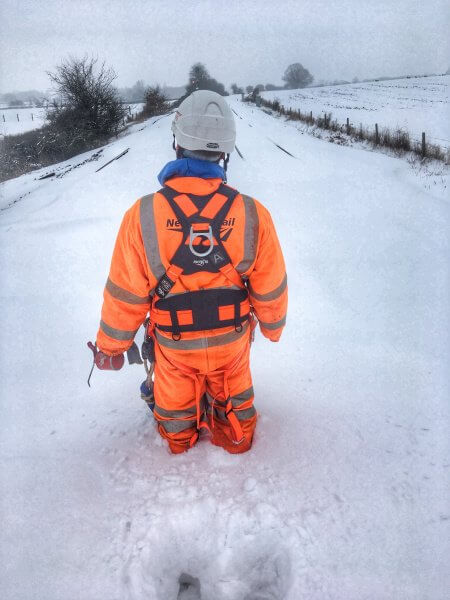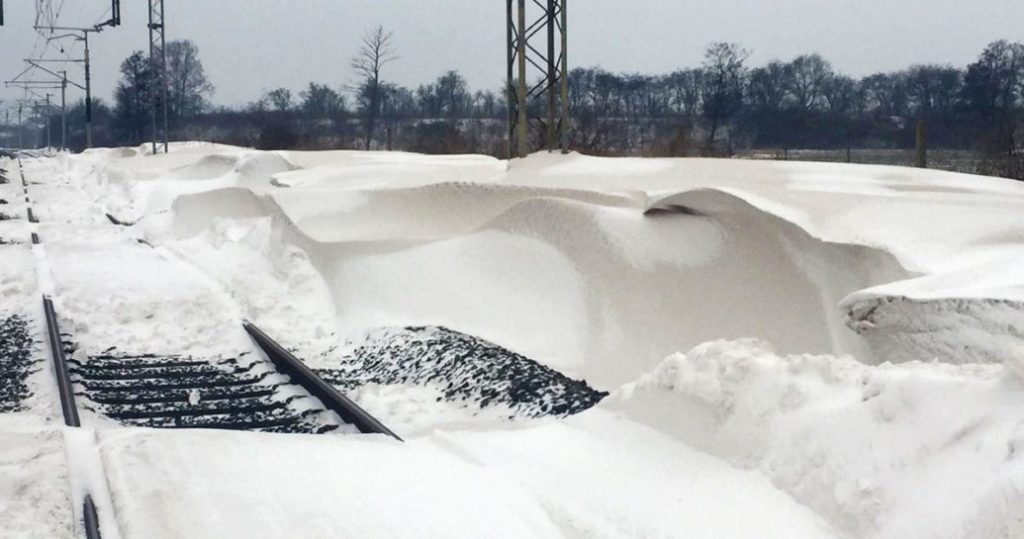We’re working hard to keep you moving in cold weather as temperatures drop across Britain.
Before one winter’s over, we’re thinking about the next. We plan ahead for snow, ice, floods and wind (as well as sudden changes between them) to keep your journeys on time and safe.
Just like road and air travel, wintry weather can pose challenges for the railway – and potential dangers to your journeys.
Its effects range from speed restrictions on exposed routes, to the suspension of train services due to avalanches.
What are some of the biggest concerns and how do we deal with them?
Wind
With millions of trees lining the railway, high winds can cause branches and trees to fall onto the track, damaging the overhead wires that power electric trains and blocking the railway. High winds also mean that objects from further away can be blown onto the tracks.
Rain
In very wet conditions trains must brake and accelerate more slowly to keep everyone safe, adding time to journeys. Prolonged, heavy rain can also cause flooding and landslips which mean trains can’t run until lines are cleared and repaired.
Snow and ice
In very cold weather, snow and ice can build up on the tracks and block points, the equipment that allows trains to move between tracks. Ice can coat the electrified third rail and overhead power cables, preventing trains from drawing the power they need to run and leaving them stranded. Icicles on tunnels, bridges and other structures can also damage trains and overhead power cables.
In very snowy weather where snow lies deeper than 30cm, trains can’t run safely unless they have been fitted with snow ploughs.
Our priorities for how we run the railway change depending on the severity of the weather

Adverse weather
During adverse weather we do our best to run a full, normal service, but punctuality may be affected.
Weather is classed as ‘adverse’ if we experience either 2cm of snow in London, 60mph winds or temperatures below -3 degrees Celsius.
Extreme weather
In extreme weather conditions, we prioritise getting people home safely over running the normal timetable. We also prioritise vital rail freight to ensure the supply of essential goods across the country and fuel to power stations.
Weather is classed as ‘extreme’ if we have either 15cm of snow in London, 70mph winds or temperatures below -7 degrees Celsius.
After high winds this might mean we start services later in the morning so that our teams can make sure that lines are clear of branches and debris and are safe.
When extreme weather is forecast we also sometimes put contingency timetables in place that help us to run fewer but more reliable services.
Did you know? Our winter treatment trains treated almost 140,000 miles last winter – that’s equal to travelling round the earth three and a half times.
We work all year round so that we can run a safe and reliable service in winter
We’ve taken lots of measures to make the railway more resilient for winter.
- Put more than 100km of special heating strips on critical sections of the electrified third rail which powers trains in the south of England. This prevents ice forming and minimises the risk of stranded trains. This has reduced ice-related disruptive incidents by almost 80%.
- Added protective covers to 4,000 points and 2,500 points motors to keep snow out and prevent damage by ice falling from trains.
- Fitted many points with heating strips to melt snow and ice.

- Put up fences on major routes to prevent snow blowing onto the tracks.
- Our climate teams are doing detailed research into the resilience of our railway. This work helps us to understand where more investment is needed to improve resilience and prevent problems.
Meet our winter fleet
We run a special winter fleet – complete with snow ploughs, hot air blowers, steam jets, brushes, scrapers and anti-freeze. This fleet clears snow and ice from the tracks.
How else do we and the rail industry prepare for winter?
- 10 snow and ice treatment trains (SITTs) fitted with snow ploughs, hot air blowers, steam jets, brushes, scrapers and jets for heated anti-freeze and compressed air to quickly de-ice tracks
- 13 pairs of snow ploughs that fit to locomotives to clear deep snow from the tracks and a number of small snow ploughs.
- Thousands of our people patrol the tracks day and night clearing snow and ice from junctions and tunnels.
- Our remote temperature monitoring and a helicopter fitted with thermal imaging cameras identify points heaters that are not working effectively.
- Train companies run empty trains through the night to help keep tracks clear, and passenger trains can be fitted with snow ploughs which can clear up to eight inches of snow – if it’s deeper, we send in our fleet of dedicated snow ploughs.
- We use ballast – the stones beneath the track – treated with anti-icing fluid for our winter engineering work, as this stops it freezing together in the delivery wagons and helps us to continue working in all temperatures.
We use detailed forecasts from weather experts MetDesk to formulate local action plans during adverse weather to minimise disruption to your journeys. The forecasts cover not just the weather but how the conditions will impact on specific railway infrastructure such as the tracks, conductor rails and overhead power lines. A network of hundreds of monitoring stations also provides real-time weather data, enabling us to respond to conditions as they develop in real time.
Our winter preparedness regime begins in September each year. Special trains and equipment are fully checked and any repairs carried out, while contingency plans are reviewed and agreed with train operators to keep passengers moving during adverse weather.



